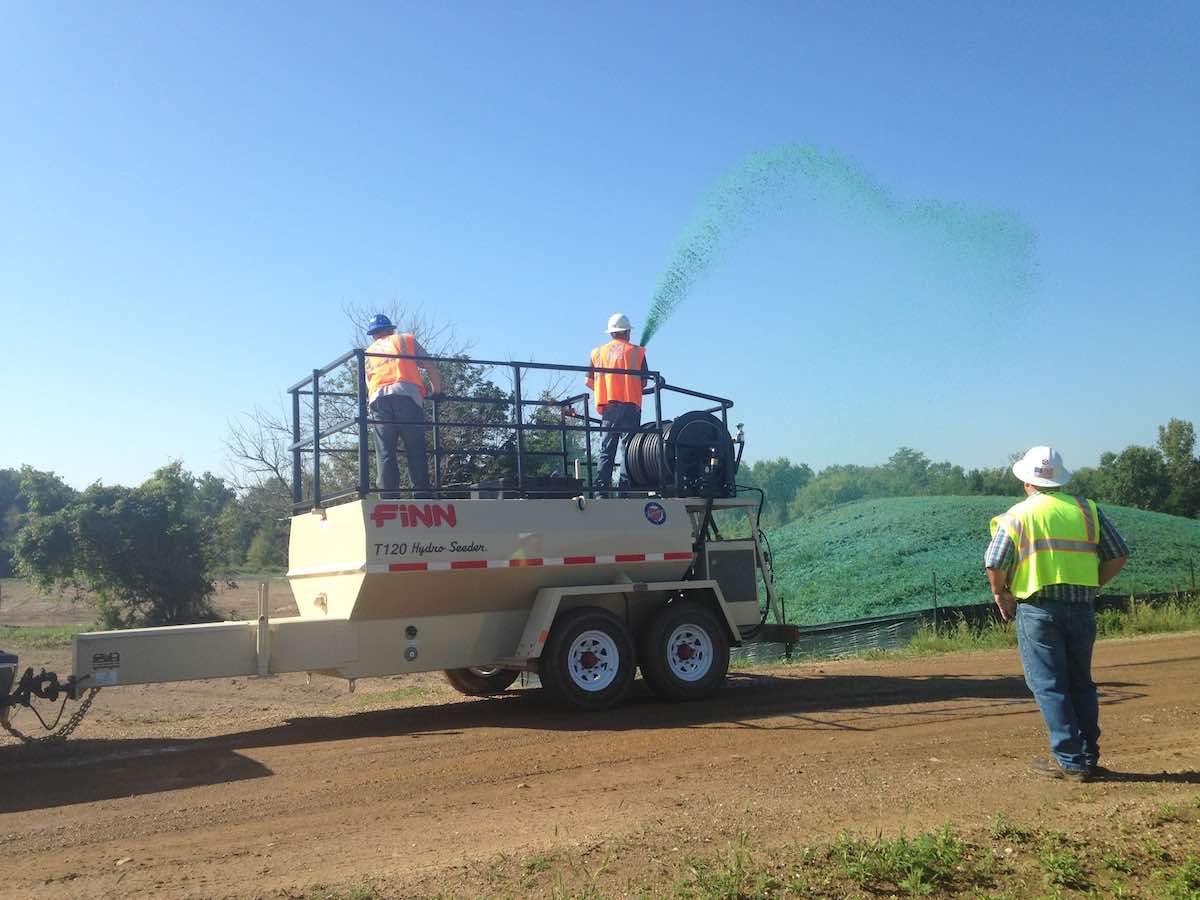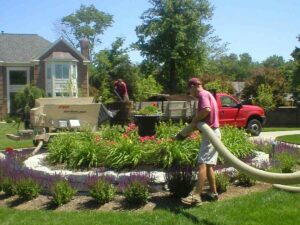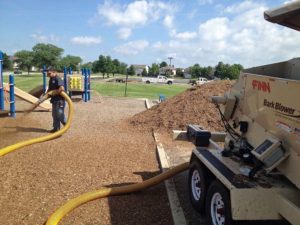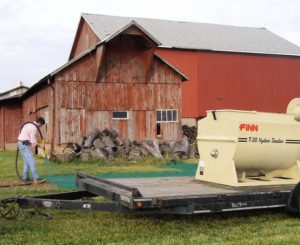How to Hydroseed: Hydroseeding Tips from the Pros

Share this article!
If you’re looking for a quick and effective way to seed a large area, get a lush, green, and healthy lawn, or re-establish vegetation in an area that’s been disrupted by construction activities or wildfire, hydroseeding, or hydromulching as it’s also commonly referred, has probably entered your radar.
And it’s easy to see why — hydroseeding is fast and cost effective, and delivers reliable, consistent results.
The Hydroseeding Process
The hydroseeding process is used to cover a large area of ground with a mixture of seeds, water, and fertilizer for purposes of stabilizing soil, establishing a lawn, or planting a large area, quickly. This process is powered by a hydroseeder, which is a piece of equipment that stores and distributes the ‘slurry’ (the combination of seeds, fertilizer, and water).
Simple hydroseeding can be done by homeowners renting the necessary equipment, or by industry professionals. Hydroseeding can be used for small projects like residential lawns, or large-scale construction projects like highway development and wildfire revegetation. As with any approach,the process of hydroseeding works well for some situations, and not for others.
How to Hydroseed: A Step-by-Step Guide
In this guide, we’ll take you through the steps you’ll need to take to do hydroseeding right, the first time. If you want a consistent result that looks great and holds up well, make sure you don’t skip any steps in the process, even though it might be tempting if you’re crunched for time.
1. Select the right time to hydroseed for your climate
Spring and fall are considered the best times of the year to hydroseed to ensure a good result from your efforts. These times of year generally provide the milder, wetter environments that are beneficial for hydroseed to establish and grow well. By contrast, because summers tend to be hotter and drier, hydroseeding in the summer can be more challenging.
After hydroseeding, the seeds require a lot of water. This makes spring a good time of year to hydroseed, since it tends to be rainy throughout much of the seasons. As with any kind of planting, you must be very aware of the weatheraround the time you want to hydroseed – frost can be hard on grass seed, slowing down and sometimes even killing seeds, so make sure you’re planning to hydroseed late enough in the spring so frost isn’t likely.
For fall hydroseeding, as long as you hydroseed 45 days or so before the first expected frost, hydroseeding in the fall can be done with great results, especially if you use cool-season grass seed varieties like Tall or Fine Fescues.
Summer hydroseeding is popular, however it requires more maintenance and water than other seasons. You will need to make sure recently hydroseeded areas have plenty of water and appropriate drainage to manage any runoff and avoid pooling. Because summers can be hot and dry, it’s often more expensive to hydroseed during these months because you’ll likely spend more in water keeping the area moist enough for seeds to take root than you would in the spring or fall.
2. Test your soil
If you’ve tried to plant in an area before without much success, testing your soil is an especially important step. Even if you’re planning to hydroseed an area that seems to support vegetation well, a soil test can help guide your choice of fertilizer and additives when it comes to your slurry.
For example: If you test your soil and determine the area is low in nitrogen, you can select a fertilizer with a high compost blend, or decide to plant a groundcover like borage to help establish better nitrogen levels in the area before you hydroseed. Nitrogen is especially important for grass to grow thick, lush, and green, so discovering any issues with a soil test can save you a lot of time down the road.
Soil test kits are available at major hardware store chains, and you can also find soil test services in your area for more accurate, in-depth results.
3. Select your seeds
The right kind of seed for your hydroseeding project will often vary depending on the climate, terrain, project, and desired result. For example, if you’re looking for a lush, green lawn for a golf course or sports field, you’ll probably be choosing different seeds than if you’re planting cover crops for highway construction erosion control.
There are many varieties of grass to choose from, since hydroseeding itself doesn’t require a special kind of seed. Commonly hydroseeded grass crops include varieties like bluegrass, fescues (great for a golf course), rye, bahia, and bermuda grasses, and grasses native to the area you’re working in. Even groundcover crops like vetch (great for erosion control) or wildflowers can be used in a hydroseeder, and small shrubs and bushes can be adapted for a hydroseeding-like process called ‘sprigging.’
4. Consider if tackifiers or other additives are needed
Once you’ve selected the right seed or seeds for your project, it’s time to determine what kind of additives you’ll need in your slurry. Hydroseeding additives often include chemicals called tackifiers which help the seeds stay in place once applied. Fertilizers are also added to the slurry to help seeds establish, and use less water as they do so.
Hydroseeding on a steep slope or embankment, for example, will almost always require the use of tackifiers to help the seeds establish well in the terrain. If you’re planting in an area that experiences heavy runoff or erosion, tackifiers will also be helpful in establishing grasses and root systems to help stabilize the soil.
Dyes, typically green, are also commonly added to hydroseeding slurry to help guide the application process. If you’re hydroseeding a large area, dye is a great way to help the application of seed be uniform and consistent – helping create consistently great results.
5. Prepare the ground
Now it’s time to give some thought to the physical makeup of the ground you will seed. Is the ground extremely hard or compact? Typically, in a construction site where heavy machinery may have created a cement-like surface, seed will establish better if the ground is de-compacted. Similarly, the ground may be uneven or sloped and need to be graded to ensure your finished landscape looks the way you want it.
Learning how to prepare ground for hydroseeding will help give your seeds the very best start, and help ensure you don’t have to re-seed or revisit areas for uniformity and consistency. The steps of clearing, loosening, leveling, and raking all make sure the ground is as receptive as possible to the hydroseeding process.
6. Prepare the hydroseeder
Getting your machine ready is the next step in the process. If you’ll be doing the hydroseeding by yourself, getting the machine prepped, and learning how to use a hydroseeder, is crucial. If the hydroseeder has been stored for the winter, you’ll want to make sure you de-winterize the hydroseeder by reconnecting the battery if it’s been stowed, as well as any valve connections. You may also need to reconnect the hose reel, if it’s been disconnected. If you’re unsure about any of these steps, always refer to the hydroseeder’s operating manual. Many hydroseeding best practices also recommend greasing lube points before starting any hydroseeding projects.
7. Load the hydroseeder
Before you begin to load the hydroseeder tank, turn on the equipment to let it warm up. Once it’s been running a moment, and during the rest of the warm up period, you can begin adding water to the tank. Depending on your hydroseeder model, expect to add about 50 gallons of water.
Once the tank is full, purge all the lines to flush out any old debris and to prevent any other clogging issues. Once the water level has reached below the agitator shaft, reverse the position of the agitator BEFORE loading any materials.
Load materials in the correct order, generally seed first, and according to the product’s specifications for the best hydroseeding results. After seed, add mulch, followed by fertilizer. Dye or water retention agents can be added at this stage, and then tackifiers can be added to prevent runoff.
Materials in the tank should appear well mixed before you begin applying. It may be necessary to turn the agitator position from the forward to the reverse several times before the mix is completely suspended. Once the desired consistency is achieved, make sure the agitator is in the forward position.
8. Spray the hydroseed
Once your equipment is hydroseed-ready, you’re ready to start spraying. Depending on the specific hydroseeder you’ll be using, you will be able to spray from the hose or from the tower. (Smaller hydroseeders normally won’t have a tower option.) Decide ahead of time where you’ll be spraying from so you can ensure all your valves are properly positioned for the method you’ve chosen.
Additionally, before starting to spray, you’ll likely need to turn down the agitator speed. Most hydroseed agitators have speeds for mixing slurry and transporting it to the job site to ensure the mixture is consistent. When you’re actively spraying, however, this setting will typically be too high. You should be able to see the slurry mixing, but it shouldn’t be sloshing or spraying out of the tank. It’s always best to follow the instructions in the manual for spraying. Once ready, cover the ground evenly with the slurry.
9. Hydroseed care and maintenance
Caring for your hydroseeded lawn requires consistent, even watering to help the seeds germinate and take root. Immediately after the hydroseed process is complete, make sure the area is moist, but make sure there are no areas that are heavily saturated or have standing water.
If you live in an area where you can expect regular rainfall during the time period after you’ve hydroseeded, this will likely be enough to help give your seeds a good start. If you’ve hydroseeded during the summer or fall months, you may need to water the area either with a hose or sprinkler system regularly to ensure the ground is moist enough for seed growth. Frequent, light watering will generally work best to help give your hydroseed the best possible start.
Regularly check in on the hydroseeded area to make sure it’s retaining moisture and that you’re not seeing any signs of excess runoff or water accumulation. It’s also best to keep foot traffic out of the area to help seeds establish without disruption.
How to Care for Hydroseed
Understanding how to care for hydroseed is an important part of making sure your hydroseed has the best chance for success. These are a few best practices to help make sure the seeds are healthy and have a rich foundation for growth.
Watering schedule for new hydroseed
Learning how to water new hydroseed is key, because moisture levels can help determine both how quickly, and how successfully, seeds root and establish. Establishing a consistent watering schedule for new hydroseed is an effective way to maintain consistent moisture levels, and the first 2 weeks after hydroseed is applied are especially important.
Begin watering the area after the initial hydroseed application has dried – this will generally happen overnight. When watering, use a light spray setting on a hose to avoid creating over-saturated areas. Similarly, with sprinklers, make sure the area is as uniformly covered by spray as possible, and look out for any areas where water may be collecting and adjust as needed.
Depending on the weather in the area after hydroseeding, a general rule of thumb is to water the area for about 10-20 minutes, 2-3 times per day. This can sometimes be reduced to just once daily, if the area is warm, not hot, and dry, or every other day if temperatures are cooler and the ground is naturally more moist. If there is sufficient rainfall to keep the area evenly moist, you can skip watering.
The key things to watch for are not to let the area dry out between waterings, and not to overwater the area so as to drown the seeds.
When to mow after hydroseeding
Wait for your grass to grow between 3” to 4” high before mowing your newly hydroseeded lawn for the first time. This typically takes 3-4 weeks. You will usually see sprouts within 7-10 days after seeding, depending on the seed type, climate, and prevailing temperatures.
Make sure your mower is also set to the correct height to remove only about the top ⅓ of grass — this will help prompt growth and help the grass fill in any areas that haven’t established as well as others.
Fertilizer
Wait about 30 days after the hydroseed has been applied to add additional fertilizer. Choose a time when the grass is relatively dry and then apply a thorough watering once fertilizer is applied. Look for fertilizers that are meant for new grass like starter fertilizers, those that offer a slow-release formula, or are well-balanced. Also make sure you read the instructions about how to apply any fertilizer you choose, and follow those recommendations. In general, after establishing, fertilizing your new lawn can be done once a season except in winter, or about 3 times per year.
Weed Control
Avoid using any weed killer or herbicidal products on your new hydroseed lawn for at least 3-4 months. You want to give the grass plenty of time to establish before using any weed control methods. Once grass has grown in well and established, you can select a weed control product designed for new grass.
Hydroseeding FAQs
Is hydroseeding safe?
Yes. Hydroseeding is a safe, non-toxic, and effective method to plant and establish new grass. Because no harsh chemicals are used in the process, hydroseeding is safe to use around children and animals.
Will hydroseed wash away?
In general, if the soil has been properly prepared and is not compact, hydroseed will not wash away after application. If, on the other hand, soil has not been de-compacted or prepared, there is a potential for heavy rains to partially wash away seeds if the rain occurs directly after hydroseeding has been completed. Tackifiers can help reduce the chances of seed washing away.
How long after hydroseeding can you walk on it?
It’s good to stay off a newly hydroseeded lawn until the grass is established — this should take about 5 weeks. As much as you can, keep pets and wildlife off the area as well, a mesh fencing or other barrier can help prevent any unwanted foot traffic in the area at least until the seeds can establish.
How long can hydroseed go without water?
New hydroseed can go without water for no more than a day, though this is highly weather dependent. Keeping the newly planted hydroseed moist is crucial to helping seeds germinate and establish, and ultimately giving you a lush, green lawn. If the weather is cool and damp, like in the spring, you might not need to water it all, or be able to go a day or two without watering, however you’ll still need to check the area to make sure it’s sufficiently moist every day.
How long does hydroseed take to grow?
On average, hydroseed germination takes between 5 and 7 days. Germination time depends on the seed type and climate, so if the weather is mild and wet, germination may take less time. On the other hand, if the weather is dry and cool, germination will take longer than the average. You can usually expect a full lawn that can be walked on within 5 weeks.
When is the best time to hydroseed?
Spring and fall are typically the best times of year to hydroseed, and each has their own advantages. The key to successful hydroseeding is to make sure the time you select will be relatively mild and moist, this way you’ll have as much help from mother nature as you can reasonably expect to help you grow a great-looking lawn. Hydroseeding in the spring can be done after the risk of frost has passed, and hydroseeding in the fall can be done before the first frost is expected.
How often should hydroseed be watered?
Plan to water new hydroseed about 2-3 times a day for roughly 10-20 minutes. While this schedule again depends on the weather, you want to make sure the new seeds are consistently moist. If the weather is hotter and dryer, you may need to water up to four or five times per day, and less if the weather is milder. Keep an eye on the temperatures and regularly check the area for both dry areas and any areas where water may be pooling or collecting. If you have standing water, that’s an indication you may be over watering, or you have a drainage issue.
Can you hydroseed over existing grass?
Hydroseeding over existing grass is generally not recommended. If you need to fill in areas of an existing yard, a method called overseeding can be used more successfully. Overseeding is typically done with a power rake and hand seeding. If you need to hydroseed over existing grass, it can work, however, the slurry mixture needs to be the right consistency so as not to kill the existing grass, which is often the biggest risk you take in hydroseeding over established grass.
Takeaway
Is hydroseeding right for you? With hydroseeding rentals commonly available and the process’s effective track record for starting lush, green lawns, hydroseeding can be a great solution to improve landscaping or enhance commercial projects. Understand how hydroseeding compares to other methods of seeding by viewing our hydroseeding cost calculator page — typically for the cost per square foot, hydroseeding is one of the most cost-effective methods you can use.
To learn more about hydroseeding, or to answer any other questions you might have about how to hydroseed, contact our professionals today.
Folow Finn Corporation on Social
How to Lay Mulch Evenly – When & Why to Use a Mulch Blower
Understanding the best way to spread mulch evenly can mean the difference between a great-looking, environmentally-friendly landscape, and one that falls short in both areas. From spreading mulch basics to how to spread mulch evenly, and when to use a mulch blower to achieve the desired results, these landscaper insider tips can help elevate your next project’s aesthetics and help…
Bark & Mulch Blowing 101
One of the best ways to enhance soil composition, prevent erosion, and improve the aesthetics of any landscaping project is to utilize bark and mulch blowing. For our purposes, bark and mulch blowing are effectively the same thing, and can generally be used interchangeably. Bark and mulch are both great choices to prevent weed growth and invasion, improve soil quality…
Hydroseed vs. Sod vs. Grass Seed
If you’re starting a lawn from scratch, you’ve probably come across the three common methods for seeding: sod, grass seed, and hydroseed. In order to determine the best choice for your yard, you may want to ask yourself a few questions before you get started, and familiarize yourself with each of the processes so you can make the right choice…



